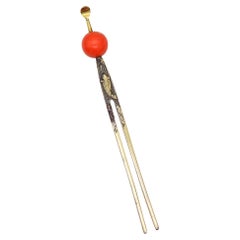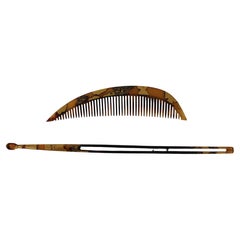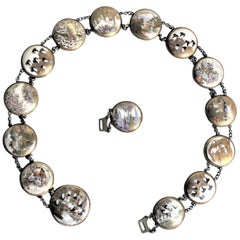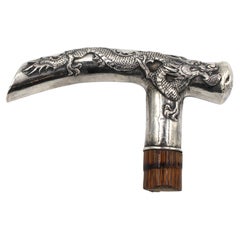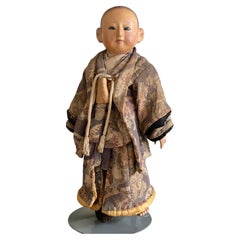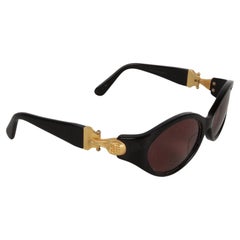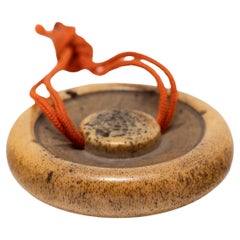Japanese Collectible Jewelry
to
1
1
3
2
1
1
2
2
1
1
1
13,911
928
385
298
252
3
3
3
Place of Origin: Japanese
JAPAN 1890 Meiji Period Kanzashi Hair Stick In Gild Sterling With Red Coral
Located in Miami, FL
A hair Kanzashi stick from the Japanese Meiji period (1868-1912).
Beautiful decorative Kanzashi hair decoration from the Japanese Imperial Meiji period, circa 1890. This hair double...
Category
1890s Meiji Antique Japanese Collectible Jewelry
Materials
Sterling Silver
19th Century Japanese Makie Kushi and Kanzashi Hair Ornament Set
Located in Worcester, GB
19th Century Japanese Makie Kushi and Kanzashi Hair Ornament Set
A fine 19th-century Japanese kushi (comb) and kanzashi (hairpin) set, crafted in tortoiseshell or similar material and decorated in the makie technique with gilt lacquer. The kushi features a gently arched form with intricately applied gold foliage and floral motifs. The kanzashi is delicately shaped, with gilt decoration echoing the comb’s design, and includes a split shank and scooped end typical of traditional Japanese hair...
Category
19th Century Antique Japanese Collectible Jewelry
Materials
Lacquer
Antique Hand-Painted Japanese Porcelain Satsuma & Silver Ladies Belt
Located in Hamilton, Ontario
This antique silver and porcelain belt was made in Japan in approximately 1900 in the period Satsuma style. The belt is a series of hand painted medallions set in silver portraying J...
Category
Early 20th Century Japonisme Japanese Collectible Jewelry
Materials
Silver
Related Items
Chinese Export Sterling Silver Walking Stick Handle, circa 1900
Located in Chapel Hill, NC
Chinese Export sterling silver walking stick handle, circa 1900. Monogram of the famous ichthyologist Dr. Hugh McCormick Smith, "H...
Category
Early 20th Century Chinese Export Japanese Collectible Jewelry
Materials
Silver
$180 Sale Price
20% Off
H 0.75 in W 2.75 in D 4.38 in
Ichimatsu Ningyo Doll from Japan Around 1890
Located in Hamburg, DE
Ichimatsu Ningyo doll is a Japanese shell limestone doll from the Meiji period. The doll body as well as the head, forearms, hands, legs and feet are made...
Category
1890s Meiji Antique Japanese Collectible Jewelry
Materials
Limestone
Antique Hand Carved & Hand Painted Gothic Revival Wall Bracket, Shelf or Corbel
Located in Lisse, NL
Quality carved, great design and good condition Gothic wall console / bracket / sculpture stand.
This practical size, architectural church bracke...
Category
19th Century Gothic Revival Antique Japanese Collectible Jewelry
Materials
Iron
$2,221
H 11.3 in W 12.7 in D 12.2 in
19th Century Edo-Meiji Period Samurai Tantō Knife/Short Blade Sword and Scabbard
Located in North Miami, FL
19th century Edo-Meiji period samurai Tantō knife/short blade sword and scabbard
By: unknown
Material: iron, metal, paint, steel, leather, wood, lacquer, metal
Technique: forged, ha...
Category
19th Century Meiji Antique Japanese Collectible Jewelry
Materials
Metal, Copper, Steel, Iron
$1,700
H 12 in W 1.5 in D 1 in
Rare 19th Century English Tunbridgeware Hair Pin or Slide
Located in Dallas, TX
PRESENTING an EXTREMELY UNIQUE and RARE 19C British Tunbridgeware Hair Pin/Bobbin or Slide.
This slide is unlike any of it’s kind we have seen before, it is a VERY RARE survivor.
From circa 1860 – 80 and made in Tunbridge Wells, England.
Made of walnut with gorgeous marquetry inlay on the entirety of the front with classic Tunbridgeware micro-mosaic all over the front. The rear is walnut.
The marquetry inlay appears to be various different woods, namely, maple, walnut and satinwood.
Would have been worn in a Lady’s hair bun with the micro-mosaic facing forward.
This would have belonged to a VERY ELEGANT LADY in the mid to late 19th Century.
Tunbridge ware is a form of decoratively inlaid woodwork, typically in the form of boxes, that is characteristic of Tonbridge and the spa town of Royal Tunbridge Wells in Kent in the 18th and 19th centuries. The decoration typically consists of a mosaic of many very small pieces of different coloured woods that form a pictorial vignette. Shaped rods and slivers of wood were first carefully glued together, then cut into many thin slices of identical pictorial veneer with a fine saw. Elaborately striped and feathered bandings for framing were pre-formed in a similar fashion.
There is a collection of Tunbridge ware in the Tunbridge Wells Museum and Art Gallery in Tunbridge Wells.
The famous makers of Tunbridge ware were in the Tunbridge Wells area of Kent; their most notable work was from circa 1830-1900.
Early makers of Tunbridge ware, in Tunbridge Wells in the mid-18th century, were the Burrows family, and Fenner and Co. In the 19th century, around 1830, James Burrows invented a technique of creating mosaics from wooden tesserae. Henry Hollamby, apprenticed to the Burrows family, set up on his own in 1842 and became an important manufacturer of Tunbridge ware, employing about 40 people.
Edmund Nye (1797–1863) and his father took over the Fenner company when William Fenner retired in 1840, after 30 years in partnership with him. Thomas Barton (1819–1903), previously apprenticed at the Wise factory, joined the Nyes in 1836, and worked as Nye’s designer; he took over the business in 1863 and continued there until his death.
In Tonbridge (near to Tunbridge Wells), George Wise (1703–1779) is known to have had a business in 1746. It continued with his son Thomas, and Thomas’s nephew George (1779–1869), who took over in 1806. In its early years the company made articles such as workboxes and tea caddies with prints of popular views; later items had pictures created from mosaics. Their workshop in Tonbridge, Wise’s Tunbridge Ware Manufactory, was next to the Big Bridge over the Medway; the building was demolished in 1886 to widen the approach to the bridge.
Tunbridge ware became popular with visitors to the spa town of Tunbridge Wells, who bought them as souvenirs and gifts. Articles included cribbage boards, paperweights, writing slopes, snuffboxes and glove boxes.
At the Great Exhibition of 1851, Tunbridge ware by Edmund Nye, Robert Russell and Henry Hollamby was shown; Edmund Nye received a commendation from the judges for his work. He exhibited a table depicting a mosaic of a ship at sea; 110,800 tesserae were used in making the picture.
The manufacturers of Tunbridge ware were cottage industries, and they were no more than nine in Tunbridge Wells and one in Tonbridge. The number declined in the 1880s; competent craftsmen were hard to find, and public tastes changed. After the death of Thomas Barton in 1903 the only surviving firm was Boyce, Brown and Kemp, which closed in 1927.
Marquetry was an old technique which was continued by Nye and Barton to create images such as birds or butterflies.
‘Green Oak’ as caused by the fungus Chlorociboria aeruginascens.
Stickware and half-square mosaic was invented by James Burrows in about 1830: a bunch of wooden sticks of different colours, each having triangular or diamond-shaped cross section, were tightly glued together; in the case of stickware, the resulting block was dried, then turned to form an article such as the base of a pincushion. For half-square mosaic, thin slices were taken from the composite block, and applied to a surface.
Tesselated mosaic, was a development by James Burrows of half-square mosaic; it was adopted by George Wise and Edmund Nye. Minute tesserae were used to form a wide variety of geometric and pictorial designs.
Many sorts of wood were used for the various colours; about 40 were in regular use. Only natural colors were used; green was provided by “green oak”, produced by the action of fungus on fallen oak. Designs for articles were often taken from designs of Berlin wool work.
Category
Late 19th Century High Victorian Antique Japanese Collectible Jewelry
Materials
Satinwood, Walnut
Antique Judaica Sterling Silver Mezuzah with a Scroll in Original Box ca 1890
Located in Doha, QA
This is an outstanding and extremely rare hand crafted, solid sterling silver Mezuzah in the original leather and dark purple velvet box.
It was made in Vienna, Austria between 1890 ...
Category
Late 19th Century Baroque Antique Japanese Collectible Jewelry
Materials
Sterling Silver
$5,850
H 4.14 in W 0.99 in D 0.99 in
Japanese Meiji Period Black Lacquered Trunk on Stand
Located in Kenilworth, IL
Japanese black lacquered wood trunk with engraved cast brass corner mounts and bails for the lift off cover. The brasses retain traces of their original gilding. All four sides of the case have been decorated in a restrained design of flowers and butterflies, and the interior of the trunk retains its original watercolored paper. The trunk has been mounted on a custom forged iron stand...
Category
19th Century Meiji Antique Japanese Collectible Jewelry
Materials
Brass, Iron
$2,560 Sale Price
20% Off
H 27 in W 23.25 in D 16 in
Six Kobe Toys, Japanese, Meiji Period, circa 1895
By Kobe Toys
Located in Incline Village, NV
Kobe Toys are very mysterious and not much is known about them. They were created and hand made, strictly for tourists and foreigners (never exported) during ...
Category
1890s Folk Art Antique Japanese Collectible Jewelry
Materials
Ebony
19th Century Cross
Located in Madrid, ES
19th century cross
Nice xix century cross in olive wood. Measures: 23 x 12 cm. In good condition.
Category
19th Century Gothic Antique Japanese Collectible Jewelry
Materials
Bronze
19th Century Hand Painted Oval German Porcelain Plaque KPM
Located in Vero Beach, FL
19th century hand painted oval German porcelain plaque KPM?
German porcelain plaque of the Vestal Virgin after the painting by Angelica Kauf...
Category
19th Century Belle Époque Antique Japanese Collectible Jewelry
Materials
Porcelain
19th Century Fruitwood Mortar and Pestle
Located in Coeur d'Alene, ID
19th century fruitwood mortar and pestle. Lathe work, remnants of paint or dark stain. Original pestle included.
Period: First half of the 19th century
Origin: Eastern, US
Size: 5" ...
Category
Early 19th Century Antique Japanese Collectible Jewelry
Materials
Fruitwood
19th Century Mortar and Pestle
Located in Coeur d'Alene, ID
19th century fruitwood mortar and pestle. Remnants of oxblood red and silver blue banded paint. Original pestle included.
Origin: Eastern, United States
Period: First half of the 19...
Category
Early 19th Century Antique Japanese Collectible Jewelry
Materials
Fruitwood
Previously Available Items
Vintage 90's Kieselstein-Cord Sunglasses Black & Gold "African Queen" Alligator
By Barry Kieselstein-Cord 1
Located in St. Louis, MO
1990's Vintage Kieselstein-Cord Black "African Queen" Sunglasses . These sunglasses are in very nice vintage condition with very slight use. They have a matte gold platted Crocodiles on each side with rose color lens. Measures 5.5" between arms.
From the estate of Joan Conway Crancer, daughter of the famous St. Louis painter Fred Conway, and was a passionate art collector, included in her collection were Calder Sculptures, Max Beckman...
Category
1990s Hollywood Regency Japanese Collectible Jewelry
Materials
Glass, Plastic
H 1.75 in W 5.88 in D 6 in
Japanese Shiitake Mushroom Netsuke Charm, c. 1850
Located in Chicago, IL
In 19th-century Japan, kimono-clad men compensated for the garment’s lack of pockets by wearing small pouches secured by button-like fasteners known as netsuke. Although these tiny, ...
Category
Mid-19th Century Meiji Antique Japanese Collectible Jewelry
Materials
Bone
Beautiful Necklace of Cultured Pearls, Extra Quality 'Akoya Japan' and Amethysts
By Prince Japan
Located in Madrid, ES
Beautiful necklace of cultured pearls, extra quality (Akoya Japan) and amethysts. 11 mm diameter Secure clasp and 18k gilded
silver hinges.
Long...
Category
Early 20th Century Art Deco Japanese Collectible Jewelry
Materials
Amethyst
H 19.3 in Dm 1.97 in
Advertising Design in Japan, Volume 23
Located in North Hollywood, CA
89 Annual of Ad Productions in Japan - Advertising Design in Japan Vol. 23
Published by Rikuyo-Sha, Tokyo (1988)
Japanese and English text. Excellent overview of Japanese advertisi...
Category
1990s Modern Japanese Collectible Jewelry
Materials
Paper
19th Century Japanese Double Gourd Netsuke
Located in Chicago, IL
In 19th-century Japan, kimono-clad men compensated for the garment’s lack of pockets by wearing small pouches secured by button-like fasteners known as netsuke. Although these tiny, ...
Category
Mid-19th Century Edo Antique Japanese Collectible Jewelry
Materials
Brass
MIKIMOTO 7mm. White Pearls Five Strands Neckless, circa 1950
By Mikimoto
Located in Sofia, BG
Very elegant five strand neckless of 7 mm. white pearls by Mikimoto, resting in the original box.
Great condition.
Japan, circa 1950
Category
Mid-20th Century Japanese Collectible Jewelry
Materials
Pearlware
Recently Viewed
View AllMore Ways To Browse
Swedish Wooden Plates
Table Crucifix
Table Nuit
Tea Cosy
Teak Wood Elephants
Ten Drawer Dresser
Tennis Bronze
Terra Cotta Plate
Terracotta Vase Floor
Thayer Coggin Burl Wood
The Howell Company
Thiebaut Frered
Tibetan Painted Cabinets
Tinned Copper Tray
Tip Trays Vintage
Tommaso Spinzi
Travertine Top Nightstands
Triple Wardrobe
